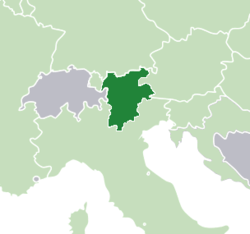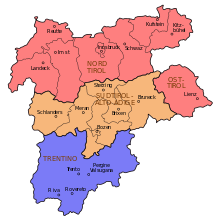Tyrol–South Tyrol–Trentino Euroregion
Tyrol–South Tyrol–Trentino Euroregion |
||
|---|---|---|
 Location of Tyrol–South Tyrol–Trentino (dark green) in Central Europe
|
||
| Type | Euroregion | |
| Membership | ||
| Establishment | 1996 | |
| Area | ||
| • | Total | 26,254 km2 10,137 sq mi |
| Population | ||
| • | 2011 estimate | 1,755,186 |
The Tyrol–South Tyrol–Trentino Euroregion (German: Europaregion Tirol-Südtirol-Trentino; Italian: Euregio Tirolo-Alto Adige-Trentino) is a Euroregion formed by three different regional authorities in Austria and Italy: the Austrian state of Tyrol (i.e. North and East Tyrol) and the Italian autonomous provinces of South Tyrol and Trentino.
Overview
The boundaries of the association correspond to the former Princely County of Tyrol, a crown land of the Habsburg Monarchy (including the former Prince-bishoprics of Trent and Brixen) which for centuries shaped life in the Alpine region.[1] Divided after World War I, the region retained much of its cultural integrity by its traditionally strong attachment to the land and a profound desire for self-government on both sides of the border. The long-standing cultural, social and economic ties, as much as the recognition of convergent interests based on its traditional role as transit country and its largely identical environmental conditions in the Eastern Alps, led to the creation of the Euroregion by the three provinces in 1998.
Linguistically, the population in Austrian Tyrol is German-speaking, while the overwhelming majority of the inhabitants of the Trentino is Italian-speaking. In South Tyrol, approximately two-thirds speak German as mother tongue and one-quarter speak Italian.[2] Overall, 62% of the Euroregion are German speakers and 37% Italian speakers. About 1% of the total population of the Euroregion speak Ladin as mother tongue, this group being mainly indigenous to South Tyrol, but also to the Trentino and Belluno.
Member regions
The Euroregion in numbers as of 31 December 2006:[3]
| Region | Surface in km² | Population (31.12.2011) | Population density per km² |
|---|---|---|---|
| Tyrol | 12,648 | 710,042 | 56.1 |
| South Tyrol | 7,400 | 511,750 | 69.2 |
| Trentino | 6,207 | 533,394 | 85.9 |
| Overall | 26,255 | 1,755,186 | 66.8 |
Co-operation
Cross-border cooperation between the three neighbours covers today many fields, including tourism, traffic, infrastructure, social services and environmental issues in the sensitive central Alps area. In 2001, the joint Alpendeklaration (Alpine declaration), a charter for sustainable development, called for a reconciliation of economic pressures with the wish of the local population to preserve its living environment. A common liaison office was set up in Brussels to foster relations with the EU.
Following a historic meeting between the parliaments of Austrian Tyrol and South Tyrol in 1971, the first in fifty-seven years, the joint meetings were extended twenty years later to include the Trentino. In the 1990s the Austrian federal-state of Vorarlberg, which enjoyed close relations with the region in the past, was granted observer status in the Three Provinces' Parliament (Dreier Landtag). Meetings of the assembly were held at various places of historical importance, such as Innsbruck and the former capital of Tyrol, Merano.
See also
References
- ↑ Excluding Cortina and Livinallongo
- ↑ Oscar Benvenuto (ed.): "South Tyrol in Figures 2008", Provincial Statistics Institute of the Autonomous Province of South Tyrol, Bozen/Bolzano 2007, p. 15, Table 9
- ↑ Homepage of Tyrol-South Tyrol-Trentino: facts and numbers
External links
-
 Media related to Tyrol at Wikimedia Commons
Media related to Tyrol at Wikimedia Commons - (English) (German) (Italian) Homepage of Tyrol-South Tyrol-Trentino
